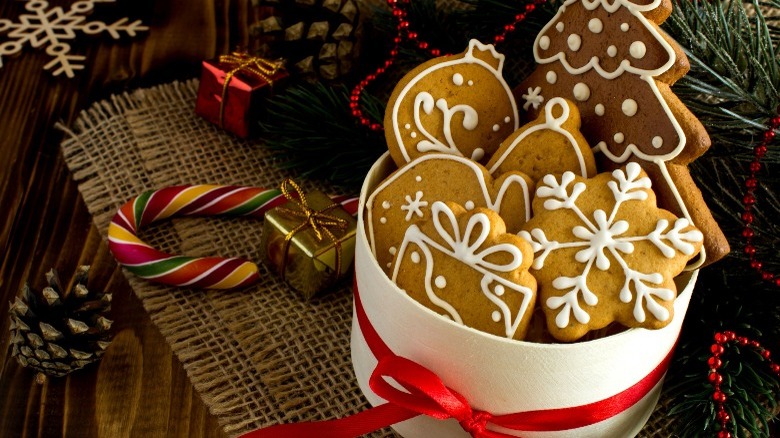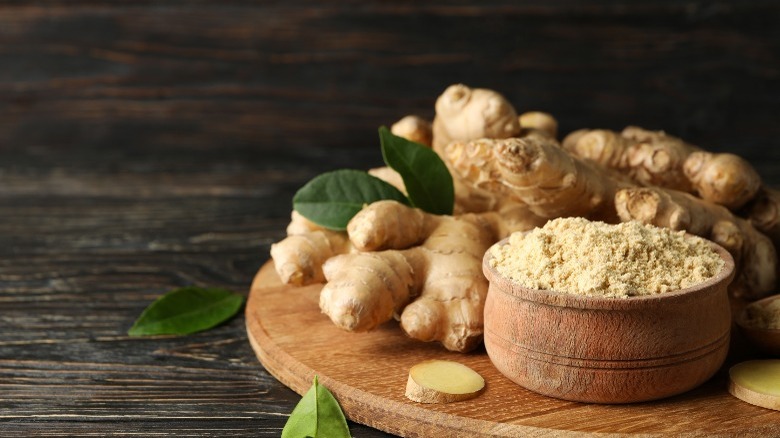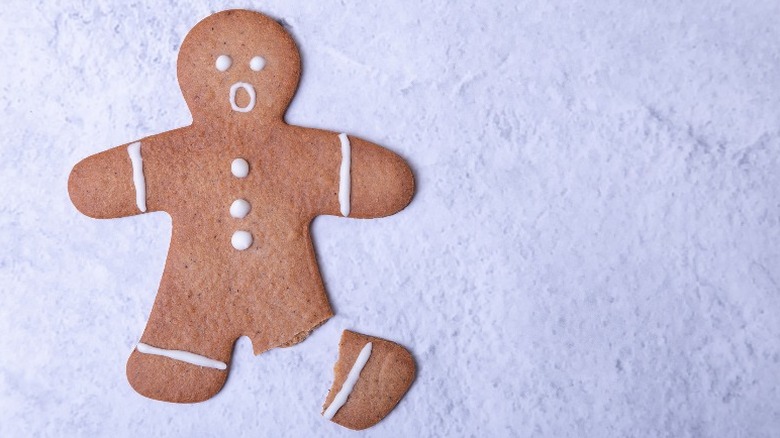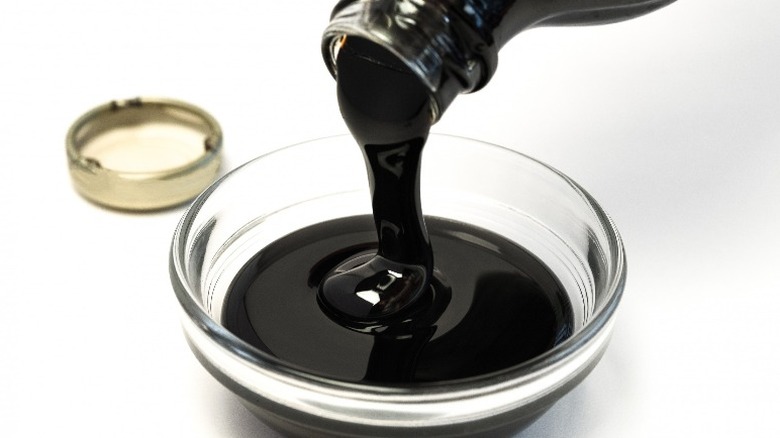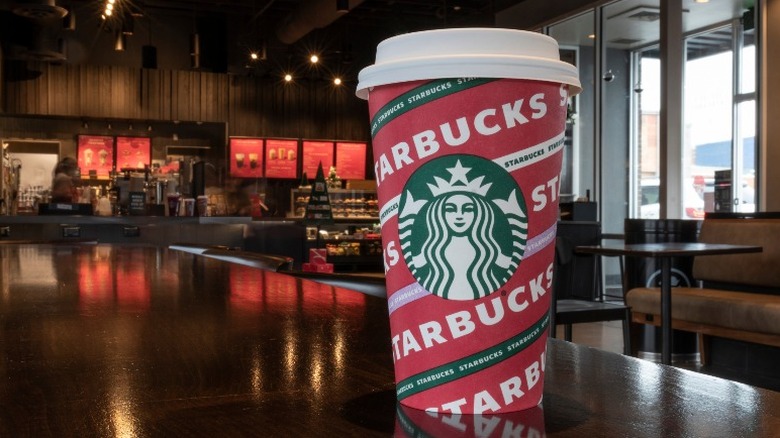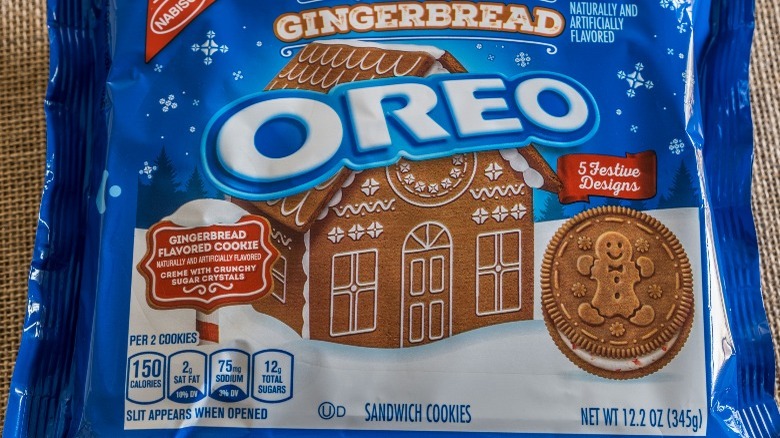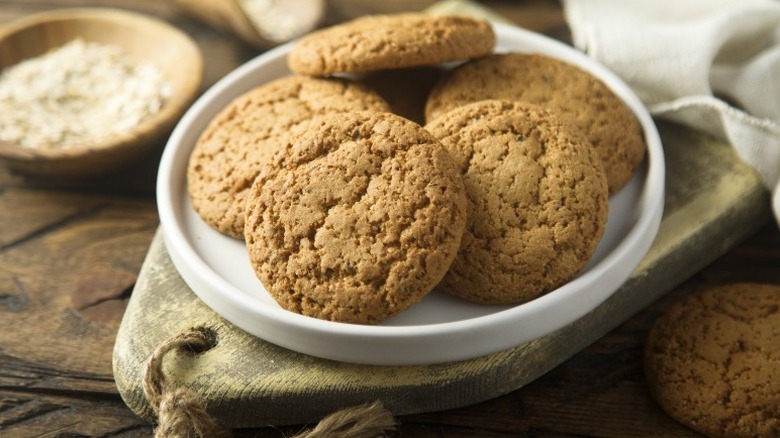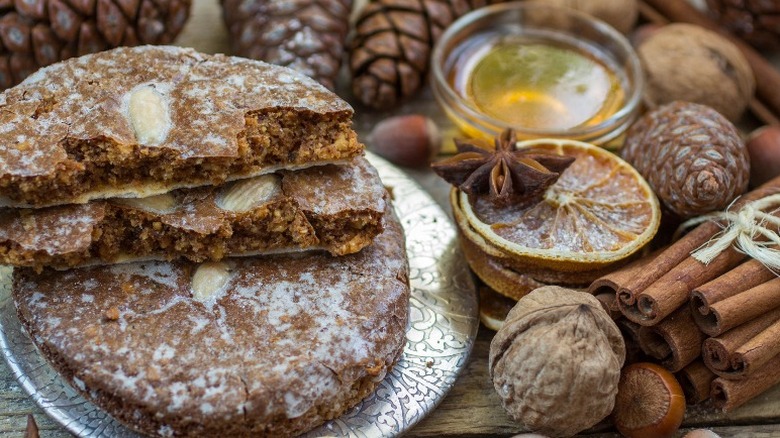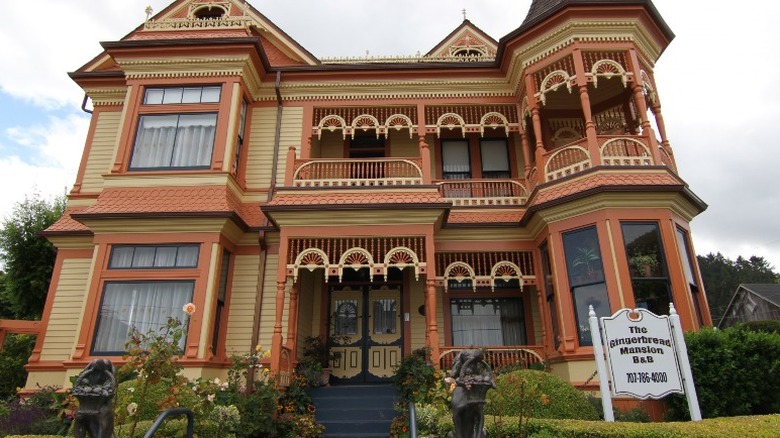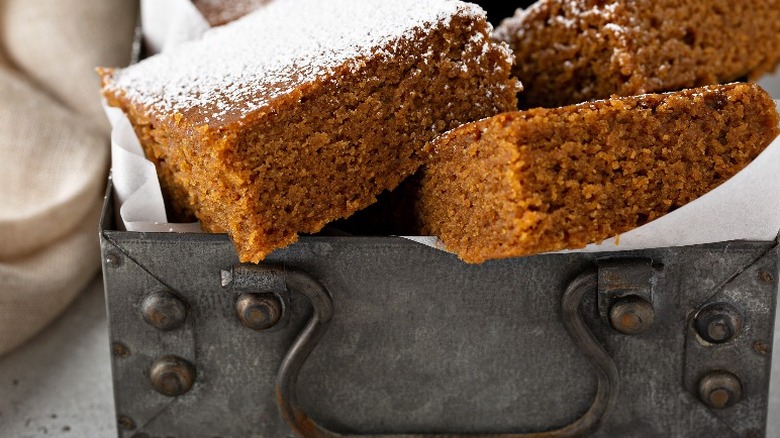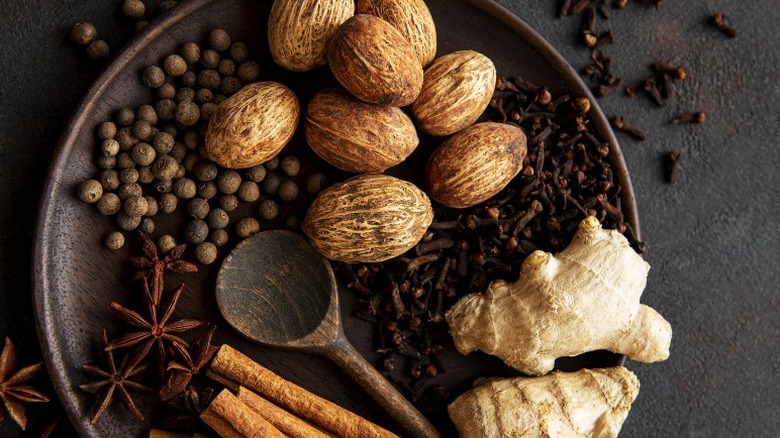Things You Should Know About Gingerbread
We may receive a commission on purchases made from links.
Gingerbread is more than just a collection of spices, sugar, and flour transformed into crispy cookies and coffee flavorings. It's also part of children's stories, an element of fairy tale lore, and a staple among Christmas treats. This sweet and spicy cookie chameleon takes on many shapes, including the ever-charming gingerbread man and whimsical, hand-decorated houses that are taken so seriously, they have their own national building contests. More than just a recipe, gingerbread is a part of Western culture that evokes nostalgia and warm memories, no matter what form it takes.
So where did gingerbread come from, and how did it become an official taste of tradition of the holiday season? It's existed for centuries, evolving through a series of archaic recipes before settling into the snappy, flavorful bake we know and love today. But it wasn't always the feel-good treat it's become over the years. It's time you got to know gingerbread a little better and learned its secrets, lore, and what makes it such a reliable seasonal comfort to so many people around the world.
Its origins are murky
For its ubiquitous presence in modern life, the true origin of gingerbread is shrouded in delicious mystery. The name itself seems sensible in English without needing translation, but according to PBS.com, the concept of gingerbread was originally intended as a means for keeping ginger preserved. Ancient Greek recipes for cakes similar to gingerbread may date back as far as 2400 B.C.
What we know now as gingerbread took a twisted path as it made its way to the Western world. Ianyanmag.com reports that an Armenian monk named Gregory Markar may have been responsible for bringing gingerbread to the West as far back as 991 A.D. and offering it to his visitors in the French countryside as a meal closer. And Smithsonian Magazine explains that the Renaissance brought popularity to gingerbread throughout Europe, with Shakespeare including a reference to it in his play "Love's Labours Lost." When a humble treat like gingerbread gets name-checked by the Bard himself, you know you're onto something special.
Ginger is an age-old ingredient
Ginger may be one of the most used spices in your baking rack, but it hasn't always been so available. According to Vegetable Facts, ginger originally appeared in Southern China and per McCormick Science Institute, it was used medicinally to help with digestion. Its presence spread westward as intercontinental trade advanced, and ginger eventually asserted itself in Europe. Ginger People explains that in the 1400s, the root was so expensive that a pound of ginger cost the same as a single sheep. The implication is that sheep were very valuable, though the exchange rate of sheep to dollars to ginger seems to have been lost to the sands of time.
Though ginger has other culinary uses, its popularity as baking spice helped grow the gingerbread phenomenon. As the website Baking Bites explains, fresh or powdered ginger can be used in baking this holiday morsel, though powdered is an easier option.
Gingerbread houses began as a German tradition
There are few symbols of the Christmas holidays more entrancing than the gingerbread house. Using boards of sweet baked dough to craft walls, roofs, shingles, and décor is a tradition anticipated each year by children and adults alike. So who came up with the idea of a cookie cottage made of this spicy sweet treat? According to food historian Tori Avery, the gingerbread house came about in Germany in the 16th century and was made even more popular by the Grimm Brothers' cautionary tale of Hansel and Gretel, those clever-yet-starving siblings who stumble onto a life-sized gingerbread house belonging to a hungry witch. While that gingerbread house turned out to be a trap of the most delicious kind, the idea of creating charming cottages out of cookies and frosting caught on.
Gingerbread houses went on to become a phenomenon and spurred the competitive nature of bakers with an eye for craftsmanship. The world record for the largest gingerbread houses built belongs to Traditions Club in Bryan, Texas, according to Guinness World Records. This house measures 60 feet long by 42 feet wide, rising to a height of 10.1 feet. Now that's a record gingerbread lovers can sink their teeth into.
Gingerbread stars in darker fairy tales and kids' stories
For all its glittering charm and sugary sweetness, gingerbread takes a turn for the creepy when it becomes a character or setting in stories meant for children, of all people. In the classic Grimm Brothers' fairy tale "Hansel and Gretel," the children in the title are lured to their fate by a gingerbread house occupied by a witch who uses her baked home to make the siblings plump enough to eat. And in "The Gingerbread Man," a baking cookie comes to life and gives chase to a series of characters before being snapped up by a greedy fox.
Why so dark, gingerbread? According to All Things Interesting, the inspiration for Hansel and Gretel may have been a famine in the 1300s, during which parents were rumored to have eaten their own children. And Smithsonian explains a trend of runaway food stories, possibly stemming from a tale called "The Fleeing Pancake" that was adapted through the years. If there's a lesson in all this gingerbread-inspired violence, it may be that the sweetest of things can hold dangers untold, and blindly trusting appearances is never a good idea.
Molasses is a key ingredient
Ginger may get a place in the name, but the thick, treacly glory of molasses helps to give gingerbread its stout flavor and deep color. This sticky sweetener arises during the sugar refinement process, according to the website How Stuff Works. The complexity helps give gingerbread its smoky depth. Southern Living explains that molasses was an affordable sweetener for Southerners in Colonial times. Combined with dried ginger and a varying blend of nutmeg, allspice, cloves, and sometimes even pepper, molasses became an important player in the story of gingerbread.
There are gingerbread recipes that omit molasses from the mix, which prompts the philosophical question, can gingerbread without molasses still be considered gingerbread? In the world of baking, where creativity is a key ingredient, the answer is that gingerbread can be whatever the person creating it wants. Whether the person who eats it agrees is entirely a matter of taste.
Gingerbread and Starbucks have a complicated relationship
For more than 20 years, Starbucks has been delighting customers with annual re-introductions of its holiday drink line-up, with new flavors stepping forward and older options retiring to the gallery. The ubiquitous Pumpkin Spice Latte that inspired a cultlike following was once accompanied by the Gingerbread Latte, a warm and familiar alternative to all that aggressive pumpkin spiciness. But the famous red holiday cups no longer feature a gingerbread quaff, a fact that Snopes.com reports is due to the drink's waning popularity. Though savvy Starbuckers can still order one, the celebratory spotlight doesn't shine on this spicy sip anymore. As is sometimes the Starbucks way, the Gingerbread Latte may make a glorious return to the happy holiday collection. For now, the elder statesman of Christmas coffee remains at the back of the menu.
Starbucks fans who long to have gingerbread gracing their favorite coffee can take comfort in knowing that gingerbread coffee is available in a home version of beans and grounds. It may take a little doing to recreate the original latte wonder, but the reward is worth the effort, especially for gingerbread devotees who'll do anything for their beloved brew.
Gingerbread-flavored treats abound
If you're craving that sweet and spicy gingerbread goodness but making your own gingerbread sounds like a tedious task, fear not. Gingerbread has become a popular flavor for many packaged products that bring seasonal joy to the most devout gingerbread worshippers. Candy lovers can indulge in gingerbread Twix and M&Ms, while cake and cookie fans can try Little Debbie's Christmas gingerbread cookies or Oreos filled with gingerbread creme. And for coffee cravers who need a hit of gingerbread in their homemade daily java, International Delights offers a gingerbread cookie dough-flavored creamer that fits nicely in any mug.
For anyone wanting to attempt their own gingerbread treats, recipes for cookies, cakes, scones, and other pastries can be found all over the internet. You can even create your own gingerbread syrup to add to coffee, cocoa, and tea. It may play second fiddle to pumpkin spice when autumn rolls around, but come winter, gingerbread gets to be a holiday diva, even if it has to make a number of appearances to make it happen.
Gingersnaps are a relative of gingerbread
It makes sense that gingersnaps and gingerbread are related. After all, gingersnaps are an iteration of the spices used in traditional gingerbread. Gingersnaps even have their own designated national day, July 1, which is separate from days commemorating other gingerbread treats. Gingerbread Day is June 5 and Gingerbread House Day is December 12, for anyone keeping track.
Gingersnaps also have a history of their own that branches off from the history of gingerbread. Food website The Nibble makes the distinction of gingersnaps as a crisper, round version of the original softer and multi-shaped gingerbread cookies that originated in Lebkuchen, Germany. According to the Museum of the American Revolution, gingersnaps were associated with Muster Day, a post-Revolutionary War occasion where new soldiers were recruited and fed gingersnaps as a celebratory snack. Gingersnaps also go by the name ginger biscuits and ginger nuts and can vary in thickness, depending on the recipe and the region in which they're made. When it comes to gingerbread, variety is a tasty prospect.
Gingerbread is loved around the world
There are versions of gingerbread in countries all across the globe, a testament to the staying power of this beloved archaic bake. Modern gingerbread is credited to Germany by way of Belgium, according to German Food Guide. An evolved form of honey cakes, lebkuchen was originally known as pfefferkuchen when it arrived in the city of Ulm in the 13th century. The name changed to lebkuchen in 1409, and gingerbread of this style went on to become a regional favorite. There's even a company called Leckerlee dedicated to selling lebkuchen exclusively all year round.
As reported by Dessert Advisor, gingerbread has international presence and is known by many names: as pepperkaker (Norway and Sweden), pão de mel (Brazil), and priyaniki (Russia), among others. In Mexico, pig-shaped ginger cookies called marranitos are a favorite treat rumored to have come about after the animal was introduced to the region in the 16th century, per to food blog The Texas Table. Whatever you call it and however it's shaped, gingerbread has been a part of global culture for a very long time!
Gingerbread houses inspired an architectural movement
Quaint cookie-based gingerbread houses were the models for architects to create houses with charming structures that call to mind fairy tale dwellings transported to a modern era. Per Apartment Therapy, gingerbread-style homes are Victorian-style houses marked by whimsical design elements like sloping roofs and lacy woodwork trim. This style hit its stride in America in the mid-1900s, the result of travelers to Haiti having been entranced by the prevalence of gingerbread homes. According to Apartment Therapy's article, vivid colors and quaint personalities for these houses earned them the name gingerbread houses in the mid-20th century, a description that remains as a quick and easy adjective.
The ornate visuals of gingerbread houses and their artful structures make them a stand-out in the world of real estate. As Cad Details Blog points out, the introduction of the scroll saw into the world of woodcutting made it possible to create the intricate trims and arches that gingerbread houses are known for. It's easier to make them out of cookies, but the movement gets an A for effort, and for its creations lasting through the decades.
Gingerbread is not ginger cake
If you can use gingerbread to make houses, can you use ginger cake to make cottages? The answer, of course, is no, because gingerbread and ginger cake are not the same thing. Gingerbread used for gingerbread houses is a cookie form of the treat, though that isn't the only form it can take. Gingerbread is also baked as a cake that bears a stronger resemblance to actual bread than gingerbread cookies do. To make things even more intriguing, you can make a ginger cake that isn't the same as gingerbread, in case your life doesn't contain enough ginger baked goods. As described by I Heart Eating, gingerbread in its cake form includes the warm flavor of molasses, while ginger cake may omit molasses in favor of bring the ginger flavor forward. And cooking site Sugar and Charm offers up a recipe for gingerbread buttercream frosting that just might push your ginger consumption into the realm of compulsion.
If all of this sounds too tasty to resist, relax and ginger on. And if all else fails, claim holiday indulgence as an excuse for going a little ginger crazy. People will understand.
Gingerbread uses specific spices
The name gingerbread makes it sound like ginger is the only star of the show. In actuality, it takes a small team of spice flavors to provide the profile that we know as gingerbread. Though it may vary from recipe to recipe, the basic formula according to My Food Job Rocks is a blend of ginger, nutmeg, cloves, cinnamon, anise, cardamom, and molasses. That sounds like a lot of things for something that only puts ginger in the title. University of Wyoming offers a breakdown of what each of these flavors contributes and adds allspice to the list. It all combines to create the warm complexity of a taste that's evolved through the centuries.
No matter how many elements it takes to create, gingerbread is a treat that contains something a singular flavor profile. Ask five different people what chocolate tastes like, and they'll have five different answers, from dark to milk to white. But with gingerbread, the flavor inspired by the name exists as a unique taste that means only one thing: gingerbread, plain and simple.

